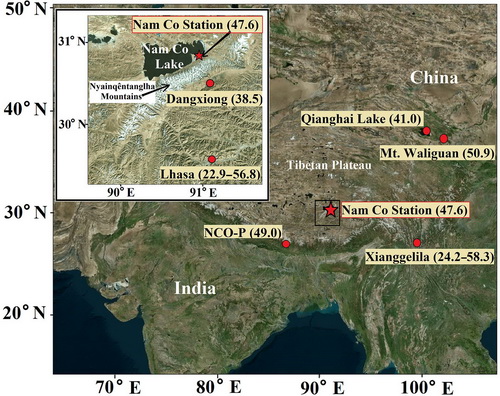Scientists Reveal the Variation Processes of Surface Ozone in the Inland Tibetan Plateau
Updatetime:2017-10-11From:
【Enlarge】【Reduce】
Surface ozone is one kind of poison pollutant and the third largest contributor of global warming, and atmospheric ozone variations are generally associated with both natural and anthropogenic processes.
The Tibetan Plateau is the highest and most extensive highland in the world and has been called the “third pole”. Due to its small human population and low level of industrialization, the Tibetan Plateau is an ideal natural laboratory for studying surface ozone across remote regions of the Eurasian continent.
The stratosphere ozone input is one of the important sources of surface ozone on the Tibetan Plateau. Due to the vast area of the Tibetan Plateau, sites in different regions exhibit different patterns of variation in surface ozone. Therefore, the variation of concentration and source of the surface ozone in the Tibetan Plateau still need to be studied.
Recently, a research group led by KANG Shichang from the State Key Laboratory of Cryospheric Science, Northwest Institute of Eco-Environment and Resource (NIEER) of the Chinese Academy of Sciences, together with the colleagues from the Lanzhou University and Saint Louis University of USA, presented continuous measurements of surface ozone mixing ratios from Jan. 2011 to Oct. 2015 at Nam Co Station in the inland Tibetan Plateau.
In this study, scientists investigated the seasonal and diurnal variations in surface ozone and its influential factors. They then evaluated surface ozone variability using combined observations over the Tibetan Plateau and beyond. Finally, they discussed the potential representativeness of surface ozone at Nam Co Station as the regional background of surface ozone in the inland Tibetan Plateau.
Research results show the surface ozone at Nam Co Station receives negligible local anthropogenic emissions inputs, and the anthropogenic contribution from South Asia in spring and China in summer may affect Nam Co Station occasionally. Therefore, the surface ozone at Nam Co Station is mainly dominated by natural processes involving photochemical reactions, vertical mixing and downward transport of stratospheric air mass.
Besides, model results also indicated that the study site is affected differently by the surrounding areas in different seasons. Air masses from the southern Tibetan Plateau contribute to the high ozone levels in the spring, and enhanced ozone levels in the summer are associated with air masses from the northern Tibetan Plateau.
This study expands the understanding of the concentration and variations in the surface ozone concentration and the transport processes that influence tropospheric ozone in the inland Tibetan Plateau, and provides a reference for future model simulations.
The research achievements have been published in the journal Atmospheric Chemistry and Physics in an article entitled “Surface ozone at Nam Co in the inland Tibetan Plateau: variation, synthesis comparison and regional representativeness”.

Geographical location of Nam Co Station and other sites in the Tibetan Plateau. (Image by KANG Shichang)
Contact
KANG Shichang
Email: shichang.kang@lzb.ac.cn
State Key Laboratory of Cryospheric Sciences, Northwest Institute of Eco-Environment and Resources, Chinese Academy of Sciences, Lanzhou, 730000, China.
Appendix




